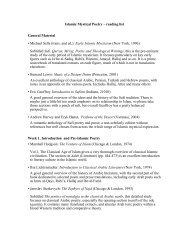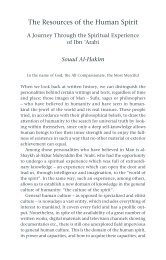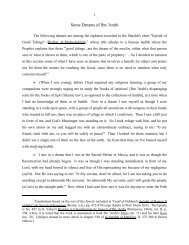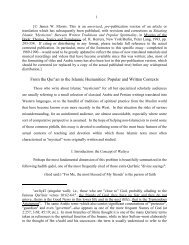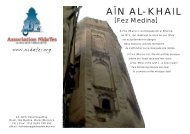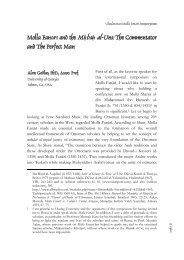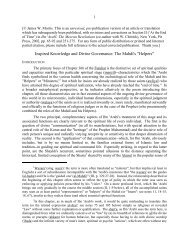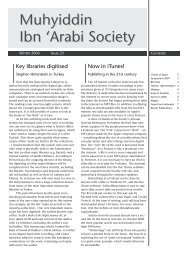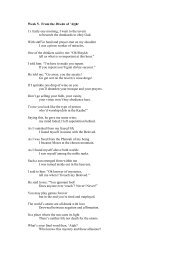Part III (pdf) - Muhyiddin Ibn Arabi Society
Part III (pdf) - Muhyiddin Ibn Arabi Society
Part III (pdf) - Muhyiddin Ibn Arabi Society
You also want an ePaper? Increase the reach of your titles
YUMPU automatically turns print PDFs into web optimized ePapers that Google loves.
28father, himself a Qâdiri master; 113 his encounter with the noted Shaykh Khâlid al-Naqshbandîduring his first pilgrimage and visit to Damascus (at age 20); and his mature study with theShâdhilî shaykh Muhammad al-Fâsî at Mecca (in 1269/1863)—Mr. Chodkiewicz clearly bringsout an indispensable dimension of <strong>Ibn</strong> ‘Arabî’s influence and spiritual function which is at oncemore fundamental and yet inherently less visible than its occasional ‘historical’ or literarymanifestations. 114 However, in ‘Abd al-Qâdir’s own exceptional case—again, not unlike <strong>Ibn</strong>‘Arabî’s—the usual forms and methods of the Sufi path (the spiritual combat of the murîd, the‘one who desires’ union) appear to have only supplemented and confirmed a special vocation forthe more direct and relatively effortless path of ‘ecstatic illumination’ (jadhba) that typifies thoserare individuals ‘chosen’ by God (the ‘murâd’). 115 Yet as the translator indicates (pp. 25-26), it113It is important to note, as the translator stresses, that the khirqa akbariyya (which‘Abd al-Qâdir’s grandfather had earlier received in Egypt) did not distinguish a separate Sufi‘order,’ but was transmitted by certain shaykhs of several tarîqas, including (at least mostrecently) the Naqshbandiyya and Shâdhiliyya. Especially interesting in this regard is the longhistorical note (pp. l83-84) on <strong>Ibn</strong> ‘Arabî’s own silsilas or chains of spiritual initiation (of whichthe note lists five, three going back to the Prophet and two to Khizr); it also mentions the initiaticsilsilas from <strong>Ibn</strong> ‘Arabî down to ‘Abd al-Qâdir, all of them beginning with Qûnawî. (Again, seeQûnawî’s central role in the lines of direct transmission of the Fusûs outlined by O.Yahia,Histoire..., II, Appendix B.)114Especially valuable in this regard is the extensive information (pp. 35-38 andaccompanying notes), drawn largely from still unpublished sources and recent studies byEgyptian and Syrian scholars, on the influences of ‘Abd al-Qâdir’s teaching and personalexample on contemporary Sufi Shaykhs in his time (primarily of the Shâdhilî and Naqshbandîorders) and their successors down to the present. On another level, but no less important, thetranslator also notes (p. 35) that it was ‘Abd al-Qâdir who financed the first publication (inCairo) of the complete text of al-Futûhât al-Makkiyya.On the historical plane which is our main focus here, this introduction also offers avaluable summary (with lengthy references in the notes) of three salient issues in the longcontroversy surrounding <strong>Ibn</strong> ‘Arabî and the Fusûs al-Hikam (see n. 5, <strong>Part</strong> II-A, and a numberof other related passages above). The questions discussed here (pp. 32-35) are the ‘faith of Pharaoh,’the ‘eternity’ of punishment in Hell, and the ‘universality’ of the Shaykh’s spiritualoutlook. Each of those points is treated, with reference to both <strong>Ibn</strong> ‘Arabî and ‘Abd al-Qâdir,with a clarity and concision that makes this section useful even for those who are not alreadyacquainted with these disputed sections of the Fusûs.115 ‘Abd al-Qâdir speaks of his own unusual path and draws the distinction between thesetwo ways—while underlining the dangers and advantages of each—in some quite revealingautobiographical remarks in Mawqif 18, the second selection (pp. 46-49) translated here. Thedistinction of murâd and murîd alluded to here, as M. Chodkiewicz points out (referring to <strong>Ibn</strong>



